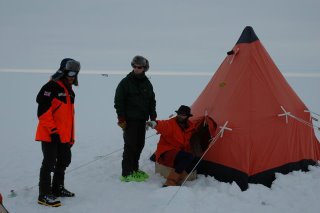Field Training
Summer is a busy time for aircraft operations, there’s depots to be dug out of snow, instruments to be serviced and measurements to be made. As Bas doesn’t employ co-pilots, we get trained to take the right-hand seat of the Otter. The first part of co-pilot training is field survival, essential as the aircraft often have to land in unknown locations to sit out poor weather!

Sune, our field assistant, took us through the equipment we’ll depend on out on the ice. The pyramid tent, stoves and lanterns, a big ‘p-bag’ (Personal Bag) of sleeping bag and mattress and a box of ‘man-food’, labelled as such to distinguish it from the former Antarctic essential, dog-food. Down here we still use Primus stoves, identical in design to those used by Scott et.al. a hundred years ago. Despite advances in technology, the humble primus has proved itself reliable and indestructible

The pyramid tents also follow proven design, known to survive in 100knot gusts. As we pitched a pair on the boundary line, I smiled as I noticed they were made in Tonypandy, a part of the Rhondda I used to cover. Once the tents were up, we loaded the food and kitchen boxes inside and all piled in to tuck into a dinner of Man Food. The dehydrated rations are similar to army issue and tasted acceptable, a flavour that will no-doubt improve after a full day out.


I slept well in the warm night (-6C). The Rab sleeping bag was twice the weight one would use for a British winter and the thick Thermarest and sheepskin kept out the cold from below. I can’t wait to get into the field.
More photos here.

Sune, our field assistant, took us through the equipment we’ll depend on out on the ice. The pyramid tent, stoves and lanterns, a big ‘p-bag’ (Personal Bag) of sleeping bag and mattress and a box of ‘man-food’, labelled as such to distinguish it from the former Antarctic essential, dog-food. Down here we still use Primus stoves, identical in design to those used by Scott et.al. a hundred years ago. Despite advances in technology, the humble primus has proved itself reliable and indestructible

The pyramid tents also follow proven design, known to survive in 100knot gusts. As we pitched a pair on the boundary line, I smiled as I noticed they were made in Tonypandy, a part of the Rhondda I used to cover. Once the tents were up, we loaded the food and kitchen boxes inside and all piled in to tuck into a dinner of Man Food. The dehydrated rations are similar to army issue and tasted acceptable, a flavour that will no-doubt improve after a full day out.


I slept well in the warm night (-6C). The Rab sleeping bag was twice the weight one would use for a British winter and the thick Thermarest and sheepskin kept out the cold from below. I can’t wait to get into the field.
More photos here.



0 Comments:
Post a Comment
<< Home